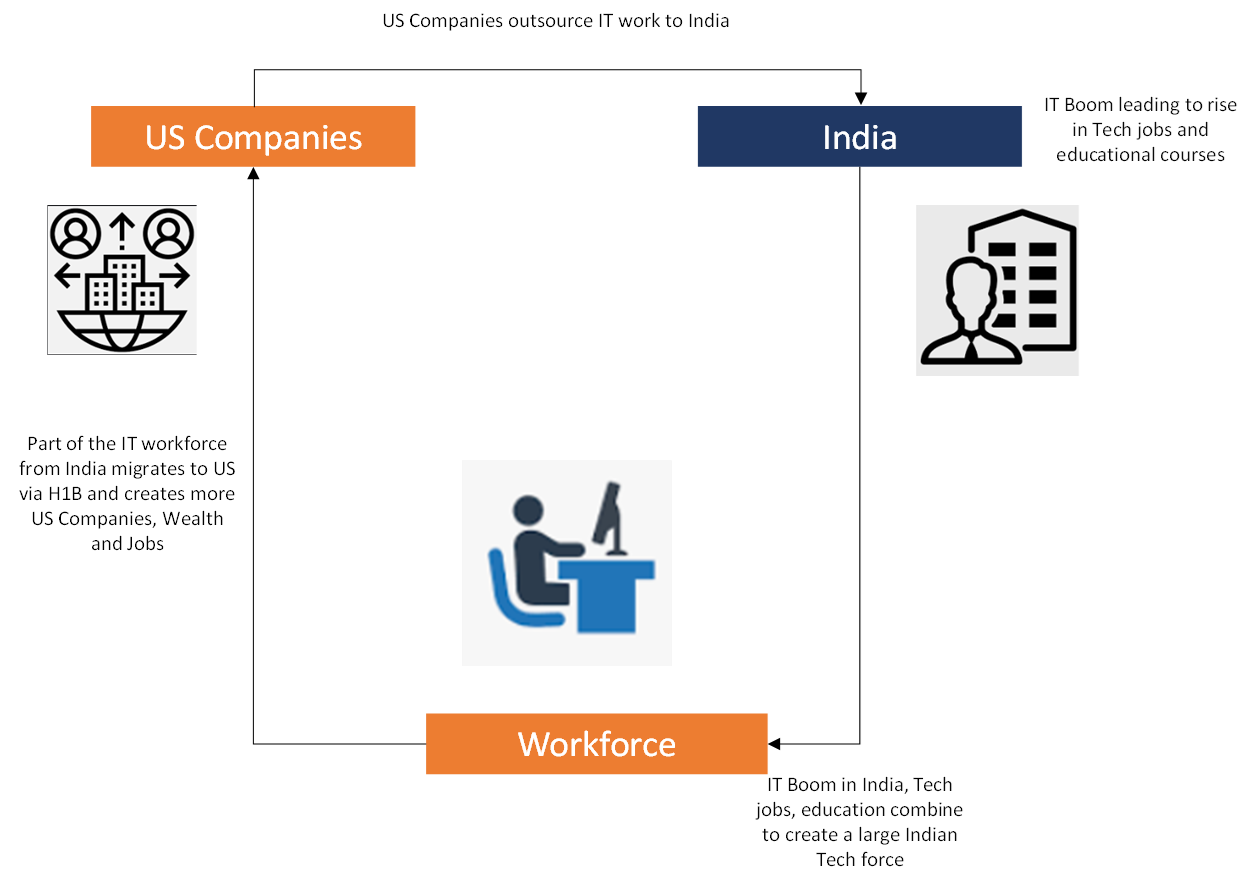Drishtikone Newsletter #356: Remote Work and the New World Order
Remote work is now mainstream. It will manifest enormous changes in nations, societies, businesses and cultures. Its impact will result in new cities, education, corporations and communities.


“Facts do not cease to exist because they are ignored.” ― Aldous Huxley, Complete Essays, Vol. II: 1926-1929
Migrations change nations and global power dynamics. The rise and fall of societies and communities are predicated on how well they can adapt to a changing world.
When humans first learned the power of agriculture, they did not need to roam the world for hunting food. They could stay in one place and generate food.
That changed our destination.
When New York developer named William J. Levitt started the concept of a suburb on Long Island, he laid the foundation of an entirely new structure of American society. Suburbs, fueled by cars, highways, and better lifestyles became the definition of American life. Americans were ready for a new lifestyle after World War II when Levitt brought it to them.
The world is now ready for a new way of living. Are we ready?
The Coming "Armageddon"?
When COVID-19 hit the world, the impact on countries like India was far more severe. Why?
Because the jobs that can be done remotely in underdeveloped countries are far lesser than in say developed economies.
16% of jobs in China and 12% of jobs in India can be done remotely, per a new McKinsey Global Institute analysis of 800 jobs across several nations. Compare that with the 33%, 30% and 29% of jobs that be done from home in the U.K., Germany and the U.S., respectively. (Source: Axios)
This is because the "in-person sectors" have a far bigger share of jobs than say in countries like India or even China.
The Washington Post, as dramatic as its owner - Jeff Bezos - called it the "Offshoring Armageddon".
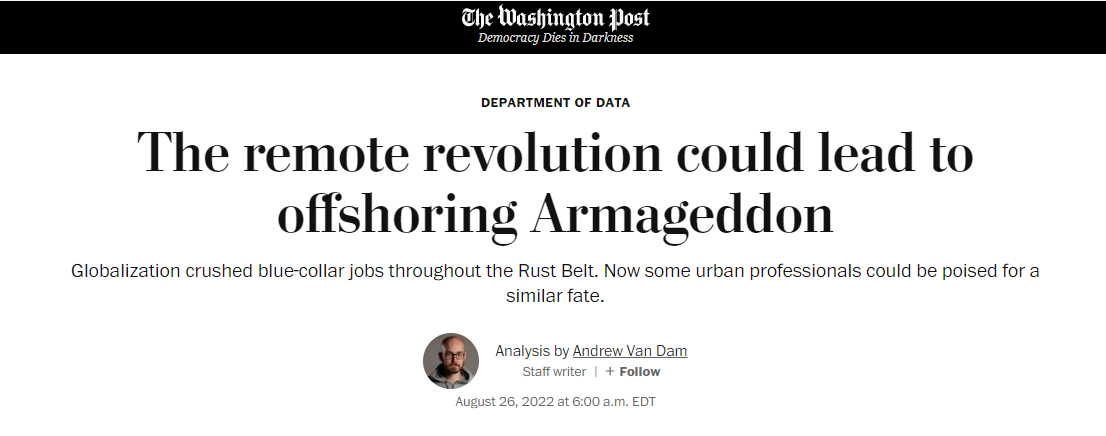
Andrew Van Dam thinks that remote work will do to the white collar jobs what offshoring of manufacturing from the Rust Belt in the US did to the population there.
As the pandemic forced them to go digital and become adept at managing a distributed workforce, some bosses consider outsourcing to be the logical next step— especially as wages soar and workers remain scarce. Companies already are turning increasingly to contractors vs. full-time employees. Relative to workforce size, the number of contractor payments in the United States skyrocketed 56 percent from 2019 to earlier this year, according to data provided exclusively to The Post by the payroll and benefits firm Gusto. By June, the 200,000-plus businesses on Gusto’s platform averaged almost two contractor payments for every employee they had on the payroll. In some industries, it’s even higher. (Source: Remote work revolution may lead to globalization of white-collar jobs)
A report in the UK from the Tony Blair Institute for Global Change titled "Anywhere Jobs: Reshaping the Geography of Work" introduces a new term - "Anywhere Jobs".
Per the report, the UK economy has 6 million "Anywhere Jobs". That's roughly one out of every five jobs. These are jobs that "can be done remotely or principally remotely as efficiently or more efficiently than in normal office working".
This may end up pushing the jobs overseas. If there is a job that can be done remotely, it can be offshored.
But is offshoring always the answer?
Remote work and the "talent shortage" in IT and engineering are "unleashing a new wave of offshoring," said Peter Bendor-Samuel, founder and CEO of the Everest Group, an outsourcing research firm in Dallas. But Bendor-Samuel also said that the rush to offshore labor may not last. Businesses need to have IT and engineering talent nearby or at least in the same time zone to drive better alignment and productivity, Bendor-Samuel said. Everest's research shows the proximity of workers delivers large productivity gains that far outweigh the cost savings of offshoring, he said. (Source: TechTarget)
While moving jobs overseas helps cut costs, it may be important to have the proximity of workers for enhanced productivity.
In the US, the salary differential between the states helps.
In a 2019 survey, for example, the average IT salaries were vastly different in different states.
While California topped with $134,531, Wyoming was the last with almost half that at $66,500! For an "Anywhere Job", moving the job from California to Wyoming gets a company an almost 50% cost cut. (Source: globalknowledge)
Of course, the logistics and the job movement - getting the talent, the amenities, the colleges to feed the talent, etc will remain major issues.
The numbers and rankings did not change a whole lot in 2021.
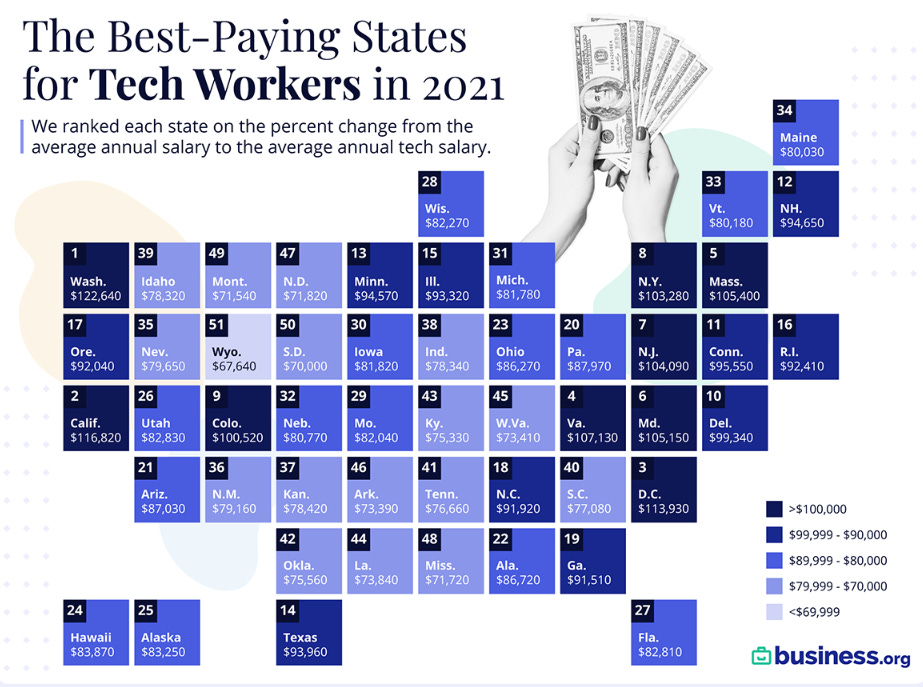
But the state differential is not always about the salaries. It is also about the cost of living and how you can live your life. Would someone want to live in New York or even within a 2-hour distance or move to say Georgia or Arizona?
Nearly one in 10 survey respondents said they are planning on a future move because of remote work, representing nearly 19 million Americans — vastly outnumbering those who reported making a move already. Upwork's numbers are consistent with other polling from Gallup, cited by The New York Times, which found that the percentage of white-collar employees working exclusively from home shot up to 65% in May 2020 from just 6% before the pandemic. (Source: Business Insider)
In some way, the flexibility that remote work brings along for people does enable employees to overlook economic hardships or even lack of salary growth. National Bureau of Economic Research at Cambridge MA found a strange phenomenon in that regard.
As inflation rises unprecedently around the globe and specifically in the US, the pressure would be high on businesses to increase wages as well because real hourly earnings have fallen by 3%!

In normal times, as economists argue, employers would need to raise wages in order to negate the inflationary loss of real income.
But a group of five economists argues in a paper that this may not be so in today's circumstances. In fact, the opposite may be true!
Why?
Because of the non-monetary benefits of remote work that has made employees accept a cumulative decline of 2% in wage growth over the two-year period.

The whole remote work started off with the impact of COVID. And now, as the impact of COVID recedes the companies are settling at the real level. In 2020, remote work peaked at 60%. Since then, in 2021 and 2022, economists José María Barrero (Autonomous Technological Institute of Mexico), Nicholas Bloom (Stanford University), and Steven Davis (University of Chicago) have found that a third of the work in the United States is done remotely.
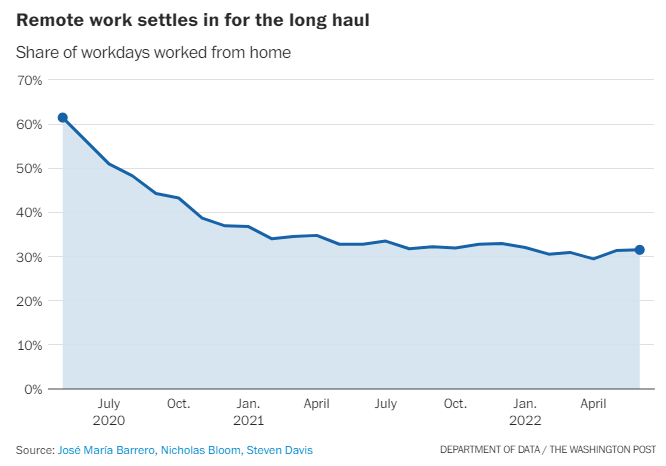
Although there are no certain numbers as to how many in the US economy are working from home, the estimates from different studies point to somewhere around 30%.
Other data points support this observation, and suggest that remote workers are switching to a hybrid schedule. A new poll shared with The Post by Gallup found 29 percent of remote-capable workers working from home full time in June — down from 39 percent in February — while the share working hybrid schedules rose a comparable amount. (Source: Washington Post)
When 30% of the American workforce is working remotely as a routine, it will set many things into motion.
How will remote work impact society
The Business Insider had an interesting article in March 2021. It shared the impact of remote work on life and society in general. Here are the five main issues they talked about.
Remote workers are more productive
Remote work has freed up relocation opportunities
Employers are hiring more independent talent
Remote workers are saving time and money
Pandemic remote work is different from remote work
One thing however stuck out from this article. That relocation will redistribute opportunities across the US.
Remote work will redistribute opportunity across the US, Ozimek wrote. Upwork estimated that up to 23 million people plan to relocate. Richard Florida, urban studies theorist and economics professor at the University of Toronto, has a similar mindset. He previously told Insider remote work will accelerate the movement of families out of superstar cities into suburbs and the 1% who are seeking lower taxes. (Source: Business Insider)
The question, however, is why not across the globe?
Already remote work is pushing employers to make radical changes in the office structures.
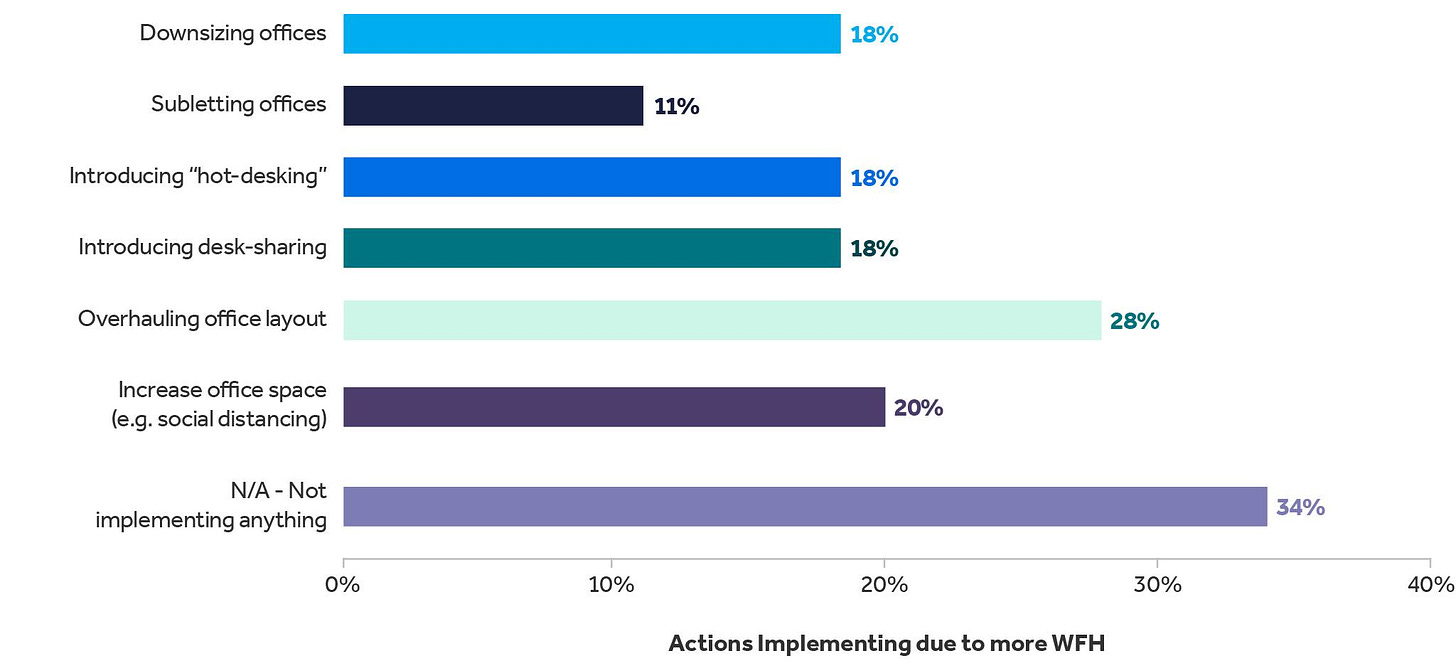
An article by KPMG shares three interesting factoids ("Work anywhere, together" / KPMG):
80% of U.S. workers say they would turn down a job that did not offer flexible working
$7 Trillion will be invested in making work digital by 2023
Based on the current state 50% increase in remote work could lead to over $11,000 in annual savings per employee.
Just soak that in for some time.
Immigration Impact: If Jobs go remote, why bring workers in?
Until now we have looked at remote work in terms of just the cost factor impact. There are also other important considerations.
Like immigration.
You see, the US allows only 65,000 skilled-worker visas under the H1B program. Another 20,000 visas are available for people who have graduate degrees from American universities.
Now, over the years immigration remains the biggest issue politically within the US. There is no meeting point between the two political spectrums. And, while the debate is about illegal migration, the legal immigrants get short shrift.
So what does the immigration impasse mean for the workers in the Tech world? Either leave the work and the workers in their country of origin (and not give the H1B visas) or bring them to another country where immigration policies allow such workers much easier.
Canada for example.
The pandemic has accelerated a trend of U.S. technology companies looking for easier ways to hire the software engineers and developers they need—and becoming far more open to remote work to get talent on board. That has meant leaving workers in their countries of origin, including India, or moving them to English-speaking countries with more lax immigration policies rather than competing for H1-B or other specialized U.S. visas, immigration reform advocates said. “There’s still a desire for the employer to have their employees in the U.S., but if that’s not possible, they will hire talent and place them where they are able to work productively,” said Stuart Anderson, executive director of the National Foundation for American Policy, a nonpartisan research organization that focuses on trade and immigration. “What the pandemic has shown is that remote work in another country can be a productive option.” MobSquad, a Canadian firm that helps match U.S. tech companies with foreign workers and relocates them to Canada, said business has quadrupled since the pandemic began and is working on placements for more than 50 companies. (Source: Tech Industry Warns That More Remote-Work Jobs Are Headed Out of U.S. / WSJ)
The fear of lack of productivity from remote work has come down substantially after COVID.
So the obvious question would be: Why even have the H1B visas anymore for the "Anywhere Tech Jobs"?
When you can offshore a job or have it done remotely, then why bring that person to the US?
Well, how will that impact the US?
Immigrants may be a political hot potato, but they add to the US economy in a big way!
Immigrants have contributed $2 trillion to the US economy in 2015-16 and Indians are “the most entrepreneurial” of all groups, a new report has claimed challenging the premise that immigrants are a drain on the world’s largest economy. The National Academies of Science, Engineering and Medicine in its report – The Economic and Fiscal Consequences of Immigration – said the estimated GDP growth due to contributions of immigrant workers amounted to nearly $2 trillion between 2015 and 2016. (Source: Financial Express)
What does this mean?
Immigrants, when they are in the US and not as remote workers in say India, contribute more to the US economy. If they were in India as remote workers, the beneficiary would be the Indian economy. That is what the battle is for now!
Now to the question that came out from the stats in the article above - Are the Indian immigrants that special? Yes, says Devesh Kapur, professor of political science at the University of Pennsylvania.
...Kapur said: “What we learned in researching this book is that Indians in America did not resemble any other population anywhere; not the Indian population in India, nor the native population in the United States, nor any other immigrant group from any other nation.” (Source: "A Singular Population: Indian Immigrants in America" / Columbia Business School)
What is so different? Indian immigrants do not create "ghettos". They assimilate into larger middle-class or even pricier neighborhoods in tech-heavy cities. Specifically the suburbs. More importantly, they prepare their kids to do the same.
From 1997 to 2013, according to the book, fully half of the 125,000 H-1B visas issued went to Indians. “The rest of the world got the other half.” Arriving with jobs and steady sources of income, Indians skipped the “ghetto stage” common to most immigrant stories, when newcomers settle in urban enclaves with other home-country refugees. Instead, the India-influx located close to their jobs, living in middle-class or pricier neighborhoods in techy communities, such as the New York-New-Jersey area, Chicago and Washington, D.C. suburbs, and the outskirts of San Francisco and Dallas. Almost without exception, they started families and primed their children to receive similar levels of educational achievement. (Source: "A Singular Population: Indian Immigrants in America" / Columbia Business School)
Bottomline - Indian immigrants have risen sharply in the last 20 years since the Y2K scare in 2000 via the H1B visa program. Typically Indians get roughly 74% of all the H1B visas every year (Source: "Indians bagged 3.01 lakh H-1B visas during fiscal 2021 – 74% of the total" / Times of India) This means that most of the Indian immigrants - roughly 41% - entered post-2010!
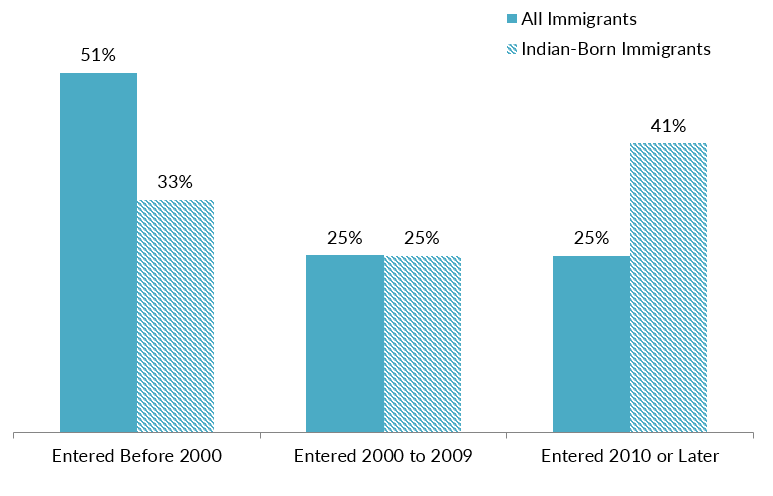
And these immigrants on H1B do not come cheap. Unlike other immigrant communities that start with low-paying jobs, Indian immigrants start off with being in the top bracket right off the bat.
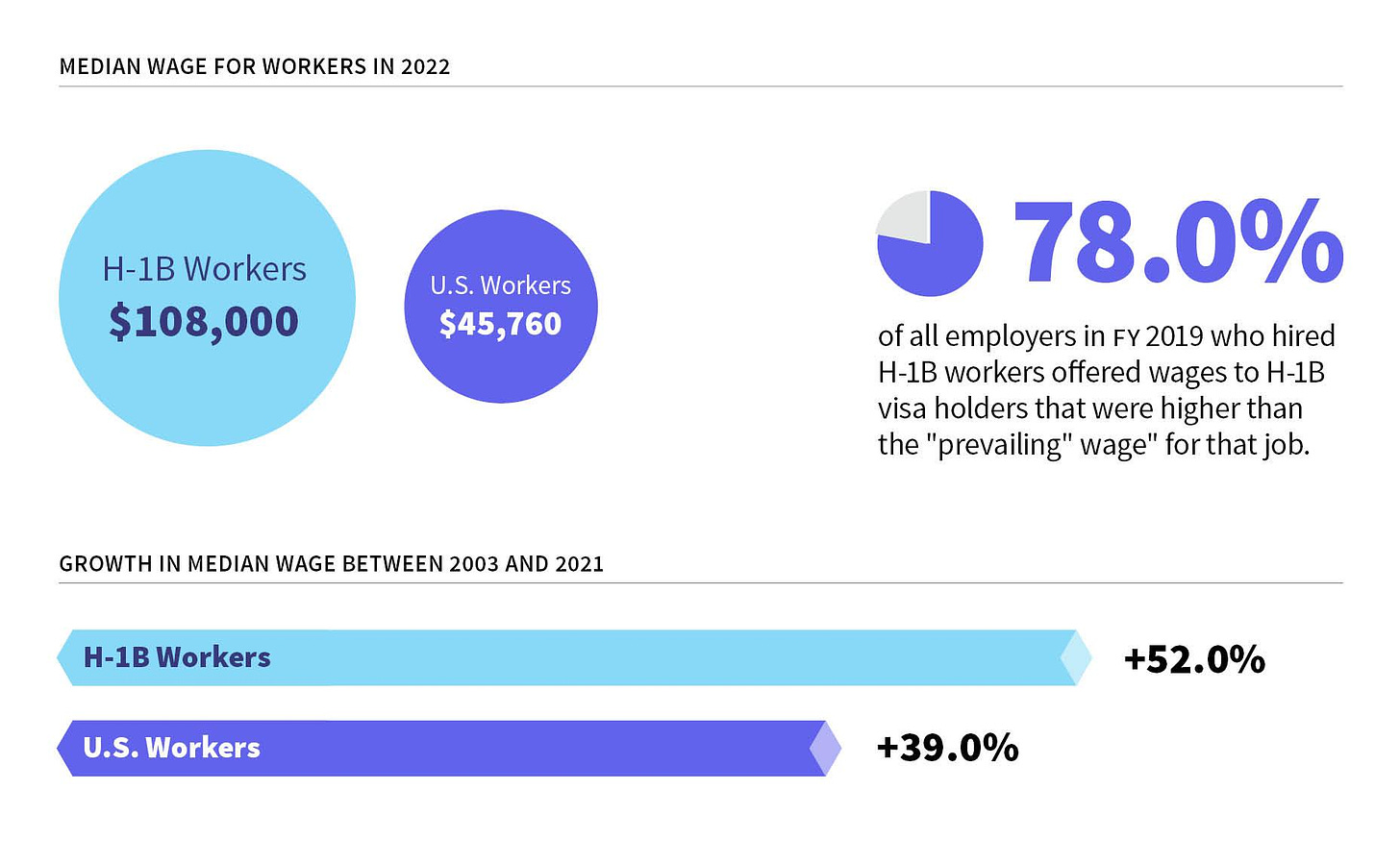
In fact, this shows in the census figures and analysis as well. Indians participate in the labor force far more than other communities.
Indians participate in the labor force at a slightly higher rate than all immigrants and the U.S.-born population. About 72 percent of Indian immigrants ages 16 and older were in the civilian labor force in 2019, compared to 67 percent of the foreign born and 62 percent of the native born. Indians were much more likely to be employed in management, business, science, and arts occupations than the overall U.S.- and foreign-born populations (Source: Migration Policy Institute)
Let us recap the main characteristics of the Indian immigrants:
The overwhelming majority Indian immigrant population has entered the US via the H1B program - mainly tech-related jobs
They do not live in ghettos. Rather they buy homes in middle-class and rich suburbs
Because they come via H1B visas, they start their life in the US with high-paying jobs right at the start
They pass on their love for education to their kids as well
This has resulted in a few things:
Over half of all the US Unicorns (start-ups valued at $1 billion) have been founded by immigrants. The biggest share is of Indians. (Source: Business Today)
Indians are the wealthiest of all communities in the US. Median household earnings of $123,700 as opposed to the national average of $63,922.
The overwhelming majorities of Indian immigrants in the US currently are the ones who are on visas. And they add to the high-income levels.
About 4 million Indians currently reside in the US, including 1.6 million visa holders, 1.4 million naturalised residents and a million are US-born residents. The median family earnings of Indians in the US is USD 123,700, nearly double the nationwide average of USD 63,922. About 79 per cent of Indians are college graduates, in comparison with the nationwide average of 34 per cent, according to the report. In fact, Indians are ahead of other Asian groups in the US in median family earnings ranges. Taiwanese and Filipinos with USD 97,129 and USD 95,000 of median family incomes respectively are in second and third place. (Source: Business Standard)
High incomes mean better jobs, better education, and also more home ownership. This has been confirmed even by the Pew Research Institute.
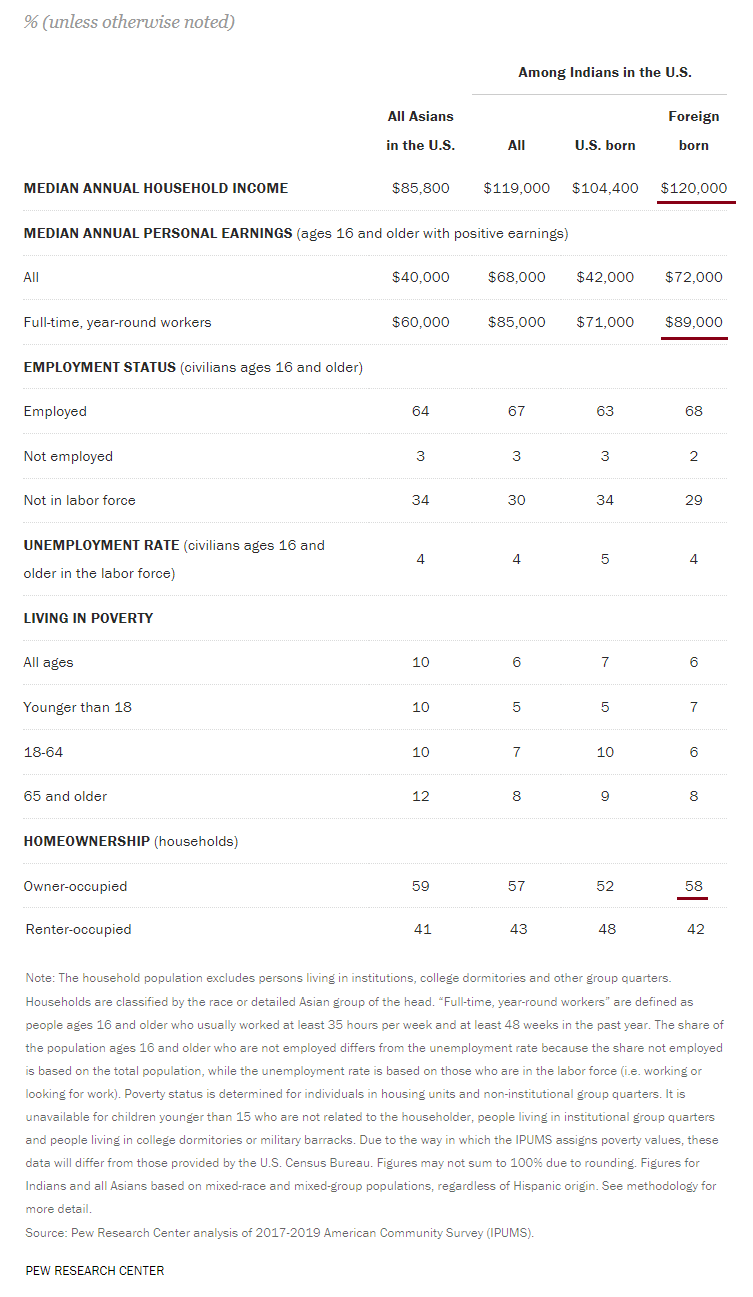
But then the question that one would like to ask is - Why the heck are we talking about the Indian immigrants so much?
Immigrants, Outsourcing, and Remote Workers
Yes, they are at the highest income, educational, and consumption levels within the US society. But so what?
The reason is that their rise and entry into the US is directly linked to the outsourcing of work.
How?
It is a complete circle. What started off as outsourcing of work for cheap created a big demand for IT workers in India. Indian ecosystem responded by creating courses, institutes, and colleges for technical education. This fueled the boom for IT work and jobs in India - creating the largest tech workforce pool in the world!
Part of that tech workforce made its way back to the US, where the outsourcing movement had started in the first place. This Indian immigrant workforce ended up pushing the US economy up with higher incomes, start-ups, home ownership, and better education.
So contrary to how it has been posited until now. Immigrants from India were a direct result of the IT boom and outsourcing of work to India. Had the work not been sent to India, Indians brought up on that IT boom would not have been prepared to move to the place which was outsourcing that work in the first place!
Jobs and Outsourcing do not necessarily have a competing relationship. On the contrary, one fueled the other. More importantly, it was about a churning of talent that was going on.
Let us look at the other social changes that remote work and immigrants bring.
Back to Remote workers and the Social Changes
That immigrants have a significant impact on the real estate industry in the US is now obvious from different studies.
Collectively immigrants add $3.7 trillion to U.S. housing wealth. Each of the 40 million immigrants in the U.S. adds, on average, 11.5 cents to the value of the average home in their local county. Given that the typical immigrant lives in a county with 800,000 housing units, this adds $3.7 trillion to U.S. housing wealth. (Source: "How 40 Million Immigrants Create Housing Wealth and Stabilize Communities" / New American Economy)
So immigration impacts real estate in a big way. Great! But what about the impact of remote work?
That also is being felt significantly now.

Because people can move and stay in different places - other than where their jobs are - the housing markets are seeing a large impact from the remote workers.
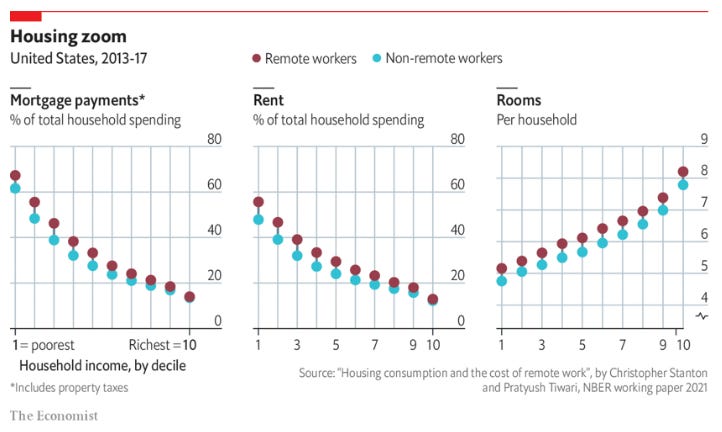
Real Estate is an indicator of how society is changing. It helps us with a quick peek into what the changes will bring.
The Coming Great Human Migration?
In 2015, Pieter Levels, a self-taught developer from Netherlands shared his predictions on the future of "digital nomads" - or remote workers. He had said that with the rising internet speeds and remote-ready work, there would be 1 billion digital nomads by 2035 (Source - levels.io).
Now he is predicting that the remote work and the changes brought about by the COVID impact will cause the greatest human migration in human history.
Here's my thesis on the next decade of remote work and how it'll transform society. I think we're on the verge of the greatest migration in human history. It won't be nomads traveling around the world perpetually, but it willbe millions of people relocating semi-permanently to places better fit for their way of living. (Source: The future of remote work: how the greatest human migration in history will happen in the next ten years / levels.io)
You see, now remote work is not just an experiment. It has become mainstream.
For businesses, this means that they are not restricted to the locally available talent but they can draw upon the entire global pool. For example, a business in New York is not restricted to 8 million people as its talent pool. It now has access to 8 billion people!
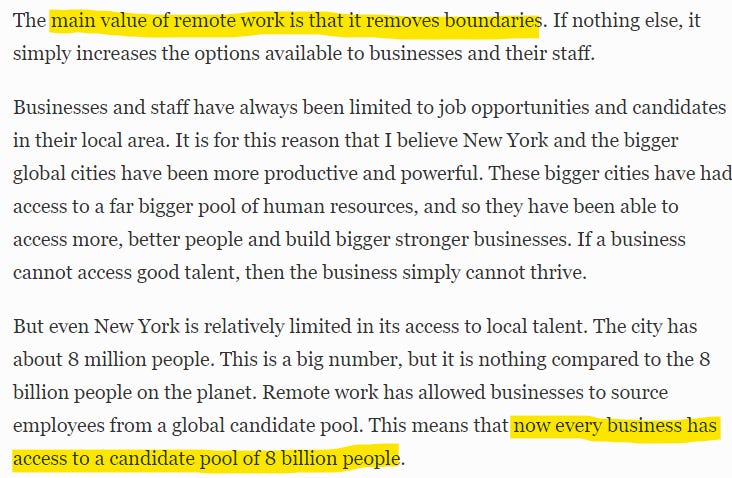
So what does this mean for the future of our cities and global movements?
Global Migration Opportunities from Mainstream Remote Work
Here are some of the larger changes in society that the mainstream remote work revolution can bring.
Community and Interest-based Living: If living is no longer restricted by where your job is then you would like to live where you find your interests and community needs fulfilling. Staying with friends, or in Bali or in the mountains. How about Nashville if you are a country music enthusiast? The options and opportunities are endless.
Creation of new types of cities: This provides town planners specifically in developing countries with resources and destinations a great opportunity to create a growing ecosystem of workers and entrepreneurs that can create the next economic boom! If you are the Chief Minister of say Madhya Pradesh (a state in India) and want to create a Zoom Town (defined by NPR as "housing markets that are booming as remote work takes off), then you may want to provide:
High-Speed reliable Internet
Great living spaces
Naturally sustainable and green environments
Cultural ecosystem of 3-4 interest types (Spiritual/Yoga/Hiking/Water Sports)
Bring together world-class educational institutes for a start-up and business ecosystem
New Growth and Innovation Centers: Stanford University has been a major factor in the growth of Silicon Valley. A Stanford study said that "More than 50% of Silicon Valley product is due to companies started by Stanford alumni" (Download report here) Once a city or a state/province in a country becomes the hub of remote workers/Digital nomads because of cultural or community interests fueled further by available amenities, the new ecosystem will enable greater innovation and growth subsequently.
New Immigration rules and programs: People go where they are welcome. Working out of a country while on a "visitor visa" or a temporary visa for say 30 or 60 days means it is an inefficient way of living for remote workers. Who would want to move to a place where s/he cannot create a life in the place? For the country where such a remote worker is operating out of it is a losing proposition as well. What could have been the basis of a long-term shift in economic opportunities is lost due to immigration rules. The answer? New "Remote Work Visas" or programs. So many countries are already welcoming long-term visitors to work remotely and are competing to attract digital nomads so that a new economy can emerge there. Check Remote Work Visas countries out.
Changing Hospitality Industry: In India, where most tech workers are young professionals, the hospitality industry is already gearing up. Resorts in Himachal Pradesh, Uttarakhand, Karnataka, Goa, Kerala and North East are creating special "Workation" packages. In fact, there is a new company Workcations which already has many properties to help remote workers reside in a place they would like - Beach or the Mountains - while they work.
Rise and Fall of Cities: San Francisco's Mayor shared that a lot of tech workers have either left the town or have been working remotely and may not ever come back to their erstwhile offices. This means that city's offices have a vacancy rate of 21-24%. This workforce contributed 72% of the city's budget. Millions of dollars are suddenly gone! (Source: Computerworld) Companies are downsizing their offices. In Portland, the vacancy rates are 17.5%. New York City has a similar trend. In terms of traffic, even though in some cities the traffic is back to pre-pandemic levels, in large cities like New York, Chicago, LA, and Dallas, there is a perceptible drop (Source: "A Little More Remote Work Could Change Rush Hour a Lot" / New York Times). Lower revenues, lower traffic, vanishing commercial tenants, and changing lifestyles - will change the fortunes of many cities going forward!
New Type of Schools and Education for kids: As the remote workers move to different communities, they will want their kids to get a great education irrespective. How to do that? High-Quality online schools combined with local classes for social interaction.
Not sure if you can see it or not, but we are looking at a radical shift in our future. New cities, new innovation centers, new government priorities, new revenue models, and new education systems are all set to evolve. In some cases, the changes are proceeding faster than we can imagine. In others, a lot needs to be done.
New World, New Geopolitics
Regardless, we are looking at a new world unfolding.
A world that will result in and be shaped by large-scale migration of people across the globe.
This will also intertwine geopolitical interests and provide social levers that were never available before. If a few million of the richest entrepreneurial Europeans and Americans decide to make Bali their home, that will change the relationship that Indonesia has with the United States.
If millions of Indian workers with strong ties back home are calling the shots in the corporate boardrooms in the United States - then the options and levers that the US establishment has in their engagement with India will change significantly.
For the countries that want to lead in the new world, it is time to use their hospitality and their people as geopolitical levers.
Old cities will fall and new metropolia will be created and take over. Will yours be in the former or the latter category?
Video Corner: The Brown Babies
Brown Babies or interracial babies born from relationships between American GIs stationed in the UK and the local white women is a painful story to even listen to. What may have happened to those people, the discrimination and the separation is something that speaks to deep discriminatory practices that US and UK have carried through in their histories.
If you like our content and value the work that we are doing, please do consider contributing to our expenses. CHOOSE THE USD EQUIVALENT AMOUNT you are comfortable with.
If you like this post - please share it with someone who will appreciate the information shared in this edition.
Today’s ONLINE PAPER: Check out today’s “The Drishtikone Daily” edition. - THE DRISHTIKONE DAILY




